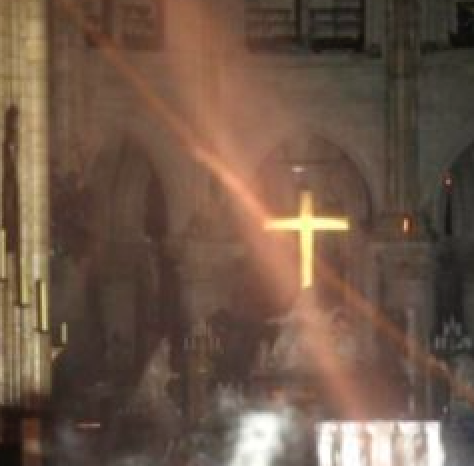Our Better Selves
A

A “Way of the Cross” as a Path to Self-giving
A pdf version of the commentary is here.
Preface
In a recent dialogue, someone asked why we seem inherently unable to be more responsive to the world’s needs; where instead we seem instinctually inclined to put ourselves and our own needs ahead of everything and everyone else? After all, our human nature, being what it is, seems hell bent on often taking a bad situation and making matters worse.
In response, two questions that immediately came to my mind. First, what might we do to be less inclined to reflect what seems to be so much a part of our human nature? If there is anything akin to a sacred spark within us, how might we be less human? And, in this same sense, what kind of example did Jesus’ sacrifice set for us, in the context of what subsequently became the Christian faith tradition?
In the liturgical expressions of the Christian faith tradition, there is the perennial season of Eastertide. Jesus having borne his cross, it’s time to once again ask in what manner we might bear our own.
The Ways of the Cross
A few weeks ago a fire alarm rang out in Paris, and the whole world seemed to turn its attention to the banks of the Seine. Nortre Dame was burning. A wooden roof constructed in the 13th century from an entire forest of trees was engulfed in flames. News cameras captured the moment the spire with a cross perched atop its peak first bent, then collapsed. And, in the smoldering aftermath behind the high altar of the sanctuary a golden cross shone through the smoke and charred timbers.
Even while the sparks were flying, news commentators, art historians, and (of course) theologians sought special meaning in what would otherwise be tagged as just another structure fire. This wasn’t simply a repository of centuries of Western history. This was “God’s house,” named after the mother of “the Lord, Jesus Christ.” And, as more than one observer commented, it was also Holy Week; the liturgical observance in the Christian faith tradition that tries to make sense out of life and death, with an affirmation of new life.
And. at the center of that search for understanding stands the cross.
While an instrument of death became the penultimate symbol of life over death for professed Christians, exactly what all that means has hardly made for a single interpretation and application as to one’s belief system; let alone how one lives their life.
Those who deduce from second-generation gospel accounts of an empty tomb and some post-resurrection appearances of some ghostly apparition as proof of a literal resuscitation of a corpse tend to place their mortal lives in the hands of some immortal god. Jesus’ self-sacrificial act for a cause greater than himself is understood as some sort of compensatory “atoning” for our shortcomings. In substitutionary theology, he paid the ransom for the rest of us, held hostage by our own “sins.” By him, in him and through him, we too – by reciting the right formulaic creed of accepting such a notion — will be saved from ourselves; along with the sorry state of affairs in which we continually seem to find ourselves.
But while appeasement of imagined gods through sacrificial offerings has been a universal staple of religious practices throughout human history, the very fact of its enduring pervasiveness seems to alone suggest a different perspective and understanding of the cross and the kind of sacrificial life it represents might be preferable, or at least considered. What might that be?
In a Westar Institute blog (the Jesus Seminar scholars) David Galston recently wondered how or why the cross of Jesus ends up being the sacred center of Christianity. “Historically,” he notes,” especially through the Middle Ages, the cross of Jesus became the object of worship. However, prior to Constantine, there were several other symbols and metaphors at play in Christianity.” He goes on:
There is also much evidence in the Q Gospel and other non-canonical gospels that for many of the earliest Christians, the crucifixion of Jesus was not a concern at all. The spirit of Jesus, and speaking in the spirit of Jesus, were concerns that featured more prominently. The earliest Christian communities were interested in living in the way of Jesus. Finally, we can also say that for many of the earliest Christians, the cross was about the integrity of Jesus, not about a sacrifice or a divine plan. “Carrying the cross” meant to walk with the same integrity; it meant to bear in your own life as a member of the body of Christ the potential persecution that came with the territory in ancient Rome. The “carrying the cross” saying does not include any explicit reference to being crucified or to the resurrection.
If one is inclined, as I am, to understand the symbol of the cross as expressing such a way of living as self-giving, I have to be honest enough to admit it goes against what is such a natural instinct in human nature. The idea of “losing oneself in order to find (or save) oneself is something that runs contrary to our “natural” instincts.
But what if we were to nail just a little more of our own self concerns to a sacrificial cross that portends to invite us to a more abundant life? Exactly what kind of “abundance” might we be talking about?
One Consideration:
An Abundance of Adequacy, or, When Enough is Enough
Galston’s blog mentioned above also included this illustration: A few months ago, a sculpture on exhibit in Israel’s Haifa Museum of Art sparked outrage. A Finnish artist named Jani Leinonenhad created a life-sized image of Ronald McDonald, nailed to a cross. As the artist put it, his artwork was meant to “criticize the encroachment of the consumer culture on our lives in general, and on the religious sphere in particular.” But after violent protest of the piece that was perceived to be sacrilegious by a group of Christians, it was removed from the exhibit.
Now, sacrilege is a peculiar notion, which can certainly be arbitrary and subjective. Whatever outward symbol may be considered “sacred” wholly depends on the meaning with which you imbue that particular object. And this certainly includes the symbol of the cross.
So it is more than ironic that the cross of crucifixion that was once the symbol of a self-sacrificial act can be considered offensive when used to express and expose our own consumption. That, and where in stark contrast, our own self-giving may be rather paltry.
This fundamental flaw that seems clearly inherent in our human nature is expressed no better than in Jesus’ parable of the Rich Fool. For further emphasis, it is also one of the parables considered by biblical scholars to have actually / likely been uttered by the historical Jesus who lived and died by way of his own cross.
There was a rich man whose fields produced a bumper crop. “What do I do now?” he asked himself, “since I don’t have any place to store my crops. I know!” he said, “I’ll tear down my barns and build larger ones so I can store all my grain and my goods. Then I’ll say to myself, ‘you have plenty put away for years to come. Take it easy, eat, drink, enjoy yourself.'” But God said to him, “You fool! This very night your life will be demanded back from you. And all this stuff you’ve collected – whose will it be now?” (Luke 12:16-21)
The parable begs the fundamental question, when is enough enough? The circle of friends, neighbors and colleagues with whom I enjoy my days have more than enough; while wealth disparity in a larger world of scarcity is a chasm that continues to widen. When might our own country and culture turn to those who have far less and, instead of saying “Sorry, we’re full,” say we have more than enough for ourselves and can afford to have less?
The symbol of the cross has typically conveyed an intersection of the human with the divine. How might it convey instead an encounter of our own selves with our own better angels? Our human nature tends to lead us to believe enough is enough is when we have just a little bit more; when whatever is perfectly adequate might be considered sufficient abundance.
In this one regard, we might ask ourselves how might we be a little less human?
© 2019 by John William Bennison, Rel.D. All rights reserved.
This article should only be used or reproduced with proper credit.
To read more commentaries by John Bennison from the perspective of a Christian progressive go to http://wordsnways.com



